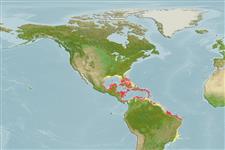>
Perciformes/Serranoidei (Groupers) >
Liopropomatidae (Painted basslets) > Liopropomatinae
Etymology: Liopropoma: Greek, leio = smooth + Greek, pro = in front of + Greek, poma, -atos = cover, operculum (Ref. 45335).
More on author: Poey.
Environment: milieu / climate zone / depth range / distribution range
Ökologie
seewasser riff-verbunden; tiefenbereich 3 - 45 m (Ref. 9710). Tropical
Western Atlantic: southern Florida, USA and Bahamas to northern South America.
Size / Gewicht / Alter
Maturity: Lm ? range ? - ? cm
Max length : 10.0 cm TL Männchen/unbestimmt; (Ref. 26938)
Rückenflossenstacheln (insgesamt): 6 - 7; Rückenflossenweichstrahlen (insgesamt): 12. Body yellow-orange with 5 wide black lines along side bordered by red above and below. Large black spot on second dorsal fin; similar spot on anal fin; caudal fin has 2 black spots connected by black bar.
A solitary species (Ref. 26340) inhabiting deep recesses of coral reefs. Common, but secretive and rarely seen (Ref. 9710). The maximum size for this species is about 8 cm standard length or 100 mm TL (value from Ref. 26938) (P.Heemstra, pers.comm. 12/09).
Life cycle and mating behavior
Geschlechtsreife | Fortpflanzung | Ablaichen | Eier | Fecundity | Larven
Robins, C.R. and G.C. Ray, 1986. A field guide to Atlantic coast fishes of North America. Houghton Mifflin Company, Boston, U.S.A. 354 p. (Ref. 7251)
IUCN Rote Liste Status (Ref. 130435)
Bedrohung für Menschen
Harmless
Nutzung durch Menschen
Aquarium: Kommerziell
Mehr Information
NamenSynonymeMetabolismusRäuberÖkotoxikologieFortpflanzungGeschlechtsreifeAblaichenSpawning aggregationFecundityEierEientwicklung
ReferenzenAquakulturAquakultur ProfilZuchtlinienGenetikElectrophoresesVererbbarkeitKrankheitenVerarbeitungNutrientsMass conversion
Tools
Zusatzinformationen
Download XML
Internet Quellen
Estimates based on models
Preferred temperature (Ref.
123201): 25.4 - 28, mean 27.2 °C (based on 200 cells).
Phylogenetic diversity index (Ref.
82804): PD
50 = 0.5000 [Uniqueness, from 0.5 = low to 2.0 = high].
Bayesian length-weight: a=0.01122 (0.00514 - 0.02450), b=3.04 (2.87 - 3.21), in cm total length, based on all LWR estimates for this body shape (Ref.
93245).
Trophic level (Ref.
69278): 3.7 ±0.6 se; based on size and trophs of closest relatives
Fishing Vulnerability (Ref.
59153): Low vulnerability (10 of 100).
Nutrients (Ref.
124155): Calcium = 110 [56, 217] mg/100g; Iron = 0.81 [0.41, 1.43] mg/100g; Protein = 18.4 [16.6, 20.2] %; Omega3 = 0.192 [0.114, 0.326] g/100g; Selenium = 25.8 [13.2, 50.5] μg/100g; VitaminA = 153 [49, 525] μg/100g; Zinc = 1.65 [1.08, 2.45] mg/100g (wet weight);
